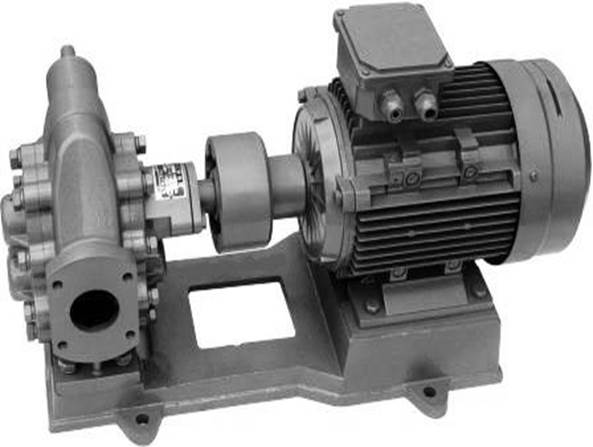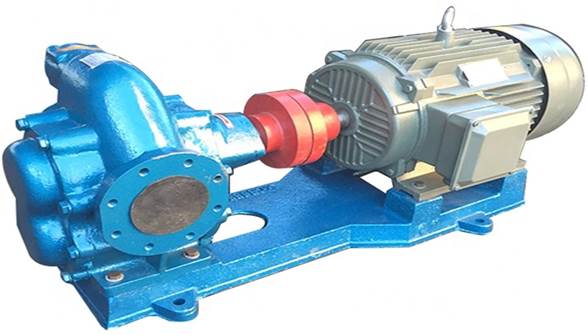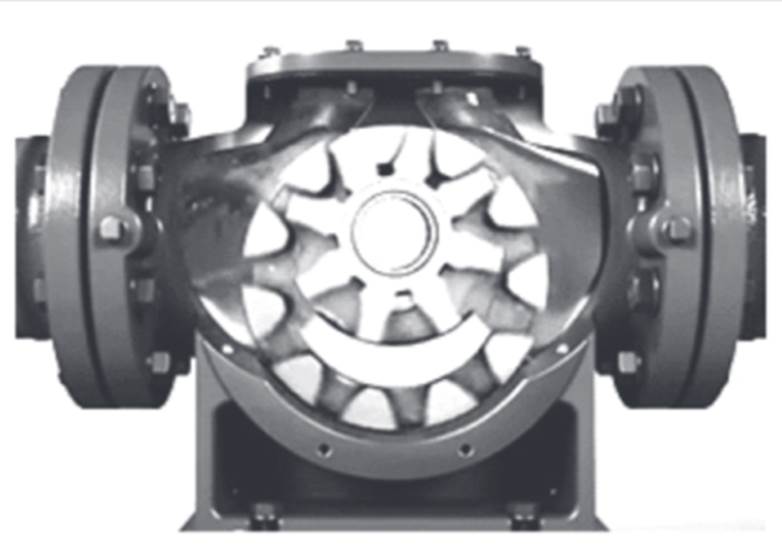Gear Oil Pump
What is a gear oil pump?
A gear oil pump is a pump that uses the meshing of gears to pump fluid by displacement. It is a typical rotary positive displacement pump, which pumps a constant amount of fluid for each revolution. The gear oil pump mainly pumps oils and other highly viscous industrial fluids. Gear oil pump manufacturers design the pump with a pair of intermeshing gears. A shaft drives one gear, and the first gear drives the second gear. Because of the close tolerances between the gears, gear oil pumps are used primarily for clean liquids. It is evident in hydraulic power systems, chemical processing plants, and oil and gas refineries. The gear pump is available in two main variations: an external gear oil pump that uses two external spur gears or an internal gear oil pump that utilizes timing gears. In comparison, the external gear oil pump can manage higher pressure and flow rates than the internal gear oil pump.

Figure: Showing the configuration of the gear oil pump.
Components of the gear oil pump
Electric motor
The gear oil pump uses an electric motor to drive the rotating element. The electric motor is an electrotechnical device that converts the electrical energy supply into mechanical energy output. The two types of electric motors are alternating current (AC) and Direct Current (DC) motors. Most gear oil pump manufacturers design the units with a DC brushless motor.
Pump body
The pump body or housing protects the rotating element and other internal components, such as the shaft, bearings, and shaft sleeves. The pump body can be constructed using various materials such as cast steel, or ductile cast iron, and brass. The gear oil pump manufacturers usually seal the pump housing to prevent leakage and retain pressure.
Shaft
The pump is a rotary mechanical component supported by the bearing and connected to the driver gear. It links the rotating element to the electric motor directly or via coupling. It is usually made from stainless steel because it is strong and can overcome vibration during pump operation.
Gears
The gear oil pump comprises a set of interlocking gears-one driver gear and one driven gear, which constitutes the rotating element. The purpose of the gears is to move the fluid through the pump body. Gear oil pump manufacturers design the gears from cast steel, heat-treated carbon steel, bronze, and alloy steels.
Mechanical seals
The mechanical seals prevent fluid under pressure from leaking out of the pump. They also prevent pump from drawing in the air under vacuum conditions.
Bearings
The bearings support the rotor assembly and ensure it aligns perfectly with the pump body. They carry the fully rotary load of the shaft during operation and minimize friction between the rotating shaft and the stator for smooth operation.
Pressure relief valve
Gear oil pump manufacturers usually fit a pressure relief valve in the pump’s discharge piping system. The essential component helps to protect the pump and piping from over-pressurizing.
How does the gear oil pump work?
The gear oil pump uses gears’ rotating action to move the fluid through the pump. When the electric motor starts, the rotating element turns, developing a liquid seal with the pump casing and creating suction at the pump inlet. As the gears come out of the mesh on the inlet side of the pump, they make an expanded volume. Oil is drawn into the pump casing, enclosed within the cavities developed between the gear teeth, and transferred from the inlet to the discharge around the outer wall inside the pump casing. The interlocking gear teeth on the discharge side of the pump reduce the volume and force the fluid out under pressure. So long as the gears rotate, their teeth repeatedly intermesh, enclosing a fixed volume of oil and transferring it mechanically in a cyclic pumping action. Once the oil reaches the pump outlet, the gears mesh and seal.
Types of gear oil pumps
External gear oil pump
An external gear oil pump comprises two identical, interlocking gears mounted within a close-fitting housing. It can use spur, helical, or herringbone gears to displace the pumped fluid through the pump. The driver gear connects with the pump shaft and runs the driven gear in the opposite direction. The gear oil pump manufacturers assemble the gears and the pump housing with delicate clearance to protect the fluid against leaking back from the discharge side and allow the pump to develop suction at the inlet. Because of the closer tolerance and a more rigid shaft, the external gear oil pump can sustain higher pressure and flow rates. This pump is highly prevalent in hydraulic power applications, typically in vehicles, mobile plant equipment, and lifting machinery.
Figure: Showing an external gear oil pump.
Figure: Showing the gear arrangement in the external gear oil pump.
Internal gear oil pump
The internal gear oil pump differs from the external gear oil pump in the arrangement of gears. An internal gear oil pump is also made up of two interlocking gears, but one rotates inside the other and in the same direction. The larger gear, called the rotor, is an internal gear, meaning its teeth project on the inside. The smaller gear, called the idler, is a spur gear located within the larger one and held in place using a pinion and a bushing attached to the pump casing. The idler gear interlocks with the rotor, allowing the gear teeth to engage at one point. The internal gear oil pump has better clearance and can operate at low speed, making it perfect for shear-sensitive liquids such as soap and paints. In contrast with the external gear oil pump, the internal gear oil pumps offer better suction capabilities and can handle more viscous fluids. It has numerous benefits, such as a wide operating range and ease of installation and maintenance.
Figure: Showing an internal gear oil pump.
Applications of the gear oil pump
Gear oil pumps are widely used in various industries such as chemical, petrochemical, soap, paper, oil and gas refineries, etc. They are vital components of hydraulic power systems in mobile plant equipment, vehicles, and lifting machinery. They are also found in automatic transmission systems, semi-automatic clutches, power steering, and propulsion systems. Typical uses of gear oil pumps include the following:
- Gear oil pumps are used as oil pumps in the engines for supplying lubricating oil and cooling purposes.
- They are used to transfer crude oil and diesel in petrochemical industries.
- They are used to lubricate the automatic or continuously variable transmission, particularly when starting or stopping the vehicle.
- They are used to pump high viscosity such as oil, paints, and resins.
- They are used in various applications with irregular supply because the pump output is only slightly affected by the pressure.
- They are used to transfer oils, vegetable fat, and butter in food industries.
Advantages of the gear oil pump
- Gear oil pumps can produce high discharge pressure (up to 5000 Psi)
- They provide smooth, pulse-free flow proportional to the rotational speed of their gears.
- They have excellent control of the output. Hence can be used as a metering pump.
- Gear oil pumps are lightweight, compact, and straightforward due to a few moving parts.
- They are self-priming and can dry-lift, although their priming characteristics improve if the gears are wetted.
- They can overcome high-temperature conditions of up to 700 degrees Fahrenheit
- They have high efficiency and low power consumption.
- They are perfect for transferring highly viscous fluids.
- The gear oil pump is bi-rotational, so the discharge end can be changed.
- They are easy to operate, maintain and reconstruct.
- They provide cavitation-free operation
Disadvantages of the gear oil pump
- The gear oil pump cannot pump fluid with suspended solid particles. Solids affect the gear rotation.
- They must always maintain a fixed clearance between the gears and the pump casing
- They require regular lubrication of the gears by the pumped fluid; thus, they cannot run dry for prolonged periods. The gear oil pump supplies more than is usually required for adequate lubrication to ensure sufficient oil delivery under extreme operating conditions.
- The gear oil pump works against back pressure, and any blockage downstream can cause pipework failure or the equipment.
- The gears require precise manufacturing and might be expensive.
- The interlocking gears can be loud.
Troubleshooting gear oil pump
The motor fails to start
- The power cable is broken. Consult a licensed electrical technician to inspect and replace any broken wires.
- The fuse is blown-out, or the circuit breaker is tripping. Inspect the pump for a blown-out fuse and replace it if necessary. Be sure to reset the circuit breaker if necessary.
- There is no power supply to the Control Panel, or the power supply is inadequate. Check the main input panel and ensure the power cable connections follows the gear oil pump guidelines.
The pump is unable to self-prime
- The motor direction is wrong/reversed. Inspect the motor rotation direction and switch the polarities if it is necessary. Ensure motor rotation matches the direction of the arrow provided on the nameplate by the gear oil pump manufacturer.
- The pump is air bound. Open the valve in the air release line.
- The lift is too high for the pump speed. Make sure you understand the suction lift requirements before selecting your pump.
The pump gives zero discharge
- The direction of motor rotation is wrong. Check the direction of the motor rotation is in line with the arrow on the casing and nameplate.
- There is an air pocket in the suction line. Fill the suction line with fluid and slope the pipework upwards. Ensure pipework is as straight and free of kinks.
- The relief valve has failed. Inspect and clean or replace the relief valve.
- There is air ingress through the seal. Inspect the seals, pipework, and connected gaskets and correct them. Replace the pump seal if necessary. Inspect the pump O-Rings and replace them if necessary.
The pump is noisy
- The pump is cavitating. Use pipes of the correct diameter following the gear oil pump manufacturer. Reduce the suction head and clean filters. Also, try reducing the pump speed and raising the fluid level in the tank.
- Vibrations in safety valves. Adjust the pressure setting to the level recommended by the gear oil pump manufacturer or replace the safety valve if necessary.
- Gears are damaged. Inspect the gear and replace them if necessary.
- There is a significant pump misalignment. Inspect the pump and realign the components if necessary.
The pump ingresses too much air
- The suction port sealing is defective. Inspect and repair pump sealing.
- The pump speed is low. Increase the pump speed to the level recommended by the gear oil pump manufacturer.
- Pipe work connections are severely worn-out. Inspect, repair, or replace the pipe connections.
Summary
A gear oil pump is a common type of positive displacement pump that uses the meshing of gears to transfer fluids by displacement. The gear oil pump manufacturers fit the pump with a pair of interlocking gears, which repeatedly enclose a fixed volume of pumped fluid and transfer it mechanically through a cyclic pumping action. Gear oil pumps apply to pump oil and other high-viscosity fluids in the chemical, petrochemical, and paper industries. These edge cutting devices gear pumps are available in two basic configurations: internal gear oil pump and external gear oil pump. The internal gear oil pump differs from the external gear oil pump in the arrangement of gears. However, in terms of operation, the internal gear oil pump has better suction capabilities and is more suitable for high-viscosity and shear-sensitive fluids. Generally, gear oil pumps offer the outstanding benefits of a compact and simple structure with few moving parts. They also have low power consumption and high energy and volumetric efficiency.



